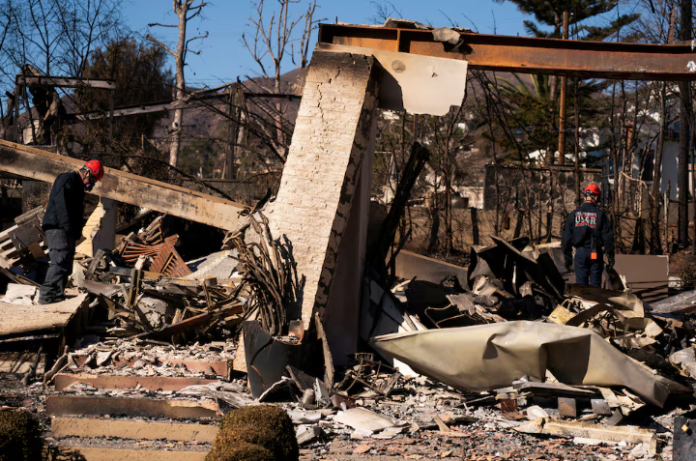Firefighters are in a race against time as two massive wildfires continue to burn across Los Angeles, fueled by dangerously dry conditions and powerful Santa Ana winds. These fires, which have already scorched an area larger than Washington, D.C., are expected to become even more volatile as wind speeds intensify.
Despite challenging conditions, an army of 8,500 firefighters from seven U.S. states and two foreign countries have managed to contain parts of the wildfires, preventing further spread for a second consecutive day. However, the danger is far from over.
The Current Fire Situation
The Palisades Fire, burning on the city’s western edge, has already consumed 23,713 acres (96 square km), with containment slowly rising to 18%. Meanwhile, the Eaton Fire, raging in the eastern foothills, has spread across 14,117 acres (57 square km) and is 35% contained.
Aircraft have been dropping water and fire retardants to battle the infernos, but operations have been periodically grounded due to strong winds.
Santa Ana Winds Pose a Major Threat
Southern California has been bone-dry since April, creating the perfect conditions for wildfires to spread rapidly. The infamous Santa Ana winds, originating from desert regions, have been whipping through canyons and across hilltops, sending embers flying up to 2 miles (3 km) ahead of the flames.
The National Weather Service has issued a Red Flag Warning, with wind gusts expected to reach 70 mph (112 kph) in mountainous areas by early Wednesday morning. These hurricane-force winds could fan the flames even further, making containment efforts even more difficult.
Death Toll and Destruction
The death toll has risen to 25, with over 12,000 structures either damaged or completely destroyed. Entire neighborhoods have been reduced to ashes, with only chimneys left standing as eerie reminders of what once existed.
In Pacific Palisades, one of the hardest-hit areas, architect Michael Kovac and his wife Karina Maher expressed “survivor’s guilt” after their fire-resistant home was spared while many of their neighbors lost everything.
“We designed the house to be both fire-resilient and sustainable,” Kovac said, emphasizing that proper planning and construction choices can make a difference in wildfire-prone areas.
Massive Evacuations and Relief Efforts
While thousands of evacuees have been allowed to return home, 88,000 residents remain under evacuation orders, with another 84,000 on high alert. This marks one of the largest displacement events in Los Angeles history.
LA Mayor Karen Bass described the devastation after taking an aerial tour, saying, “It’s one thing to see it on TV, but seeing the massive scale of destruction from the air is unimaginable.”
Meanwhile, search and rescue teams are combing through affected areas, looking for hot spots, hazardous materials, and lingering dangers.
Getty Museum’s Priceless Art Remains Safe
The J. Paul Getty Museum, which houses masterpieces by Van Gogh, Rembrandt, Monet, and Degas, was threatened by the Palisades Fire. Fortunately, the artwork is protected inside the Getty Center, which was specifically designed with fire-resistant materials.

“It would be extremely foolish to try and remove the artwork,” Getty Trust President Katherine E. Fleming reassured the public, confirming that the museum remains secure.
Political Tensions Over Emergency Aid
As the economic impact of the fires continues to rise, political battles over disaster relief funding have erupted in Washington. Private forecaster AccuWeather estimates total damage between $250 billion and $275 billion, making this the costliest wildfire disaster in U.S. history—even surpassing Hurricane Katrina in 2005.
However, House Speaker Mike Johnson has proposed that any wildfire aid should be offset by budget cuts, a move strongly opposed by Democrats like Representative Ted Lieu, who called the stance “outrageous”.
“We shouldn’t be using people’s pain and suffering as leverage for policy changes,” Lieu argued.
What Happens Next?
With winds expected to intensify, firefighters face an uphill battle in containing these relentless blazes. The next 24 to 48 hours will be critical, as any shift in wind patterns could turn controlled areas into raging firestorms.
For now, residents are urged to remain vigilant, follow evacuation orders, and stay updated on emergency alerts as Southern California braces for what could be its most destructive wildfire season yet.



